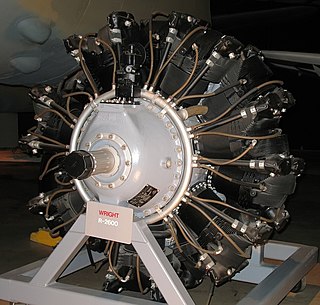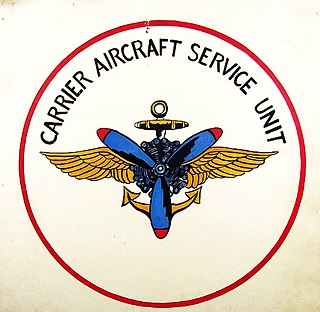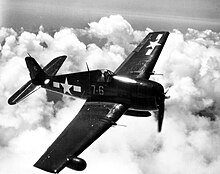
The Vought F4U Corsair is an American fighter aircraft which saw service primarily in World War II and the Korean War. Designed and initially manufactured by Chance Vought, the Corsair was soon in great demand; additional production contracts were given to Goodyear, whose Corsairs were designated FG, and Brewster, designated F3A.

The Supermarine Seafire is a naval version of the Supermarine Spitfire adapted for operation from aircraft carriers. It was analogous in concept to the Hawker Sea Hurricane, a navalised version of the Spitfire's stablemate, the Hawker Hurricane. The name Seafire was derived from the abbreviation of the longer name Sea Spitfire.

USS Bunker Hill was one of 24 Essex-class aircraft carriers built during World War II for the United States Navy. The ship was named for the Battle of Bunker Hill in the American Revolutionary War. Commissioned in May 1943 and sent to the Pacific Theater of Operations, the ship participated in battles in the Southwest Pacific, Central Pacific and the drive toward Japan through Iwo Jima and Okinawa, and air raids on the Japanese homeland.

The North American FJ-2 and FJ-3 Fury are a series of swept-wing and carrier-capable fighters for the United States Navy and Marine Corps. The FJ-2 resulted from an effort to navalize the North American F-86 Sabre operated by the United States Air Force. These aircraft feature folding wings, and a longer nose landing strut designed to increase angle of attack upon launch and to accommodate a longer oleo to absorb the shock of hard landings on an aircraft carrier deck.

The Grumman TBF Avenger is an American World War II-era torpedo bomber developed initially for the United States Navy and Marine Corps, and eventually used by several air and naval aviation services around the world.

The Douglas SBD Dauntless is a World War II American naval scout plane and dive bomber that was manufactured by Douglas Aircraft from 1940 through 1944. The SBD was the United States Navy's main carrier-based scout/dive bomber from mid-1940 through mid-1944. The SBD was also flown by the United States Marine Corps, both from land air bases and aircraft carriers. The SBD is best remembered as the bomber that delivered the fatal blows to the Japanese carriers at the Battle of Midway in June 1942. The type earned its nickname "Slow But Deadly" during this period, along with a rarely-used accompanying nickname of "Furious D."

The Grumman F4F Wildcat is an American carrier-based fighter aircraft that entered service in 1940 with the United States Navy, and the British Royal Navy where it was initially known as the Martlet. First used by the British in the North Atlantic, the Wildcat was the only effective fighter available to the United States Navy and Marine Corps in the Pacific Theater during the early part of the Second World War. The disappointing Brewster Buffalo was withdrawn in favor of the Wildcat and replaced as aircraft became available.

The Grumman F7F Tigercat is a heavy fighter aircraft that served with the United States Navy (USN) and United States Marine Corps (USMC) from late in World War II until 1954. It was the first twin-engine fighter to be deployed by the USN. While the Tigercat was delivered too late to see combat in World War II, it saw action as a night fighter and attack aircraft during the Korean War.

The Grumman F8F Bearcat is an American single-engined, carrier-based, fighter aircraft introduced in late World War II. It served during the mid-20th century in the United States Navy, the United States Marine Corps, and the air forces of other nations. It was Grumman Aircraft's last piston-engined fighter aircraft.

The Kawanishi N1K was an Imperial Japanese Navy fighter aircraft, developed in two forms: the N1K Kyōfū, a floatplane designed to support forward offensive operations where no airstrips were available, and the N1K-J Shiden, a land-based version of the N1K. The N1K-J was considered by both its pilots and opponents to be one of the finest land-based fighters flown by the Japanese during World War II.

The Pratt & Whitney R-2800 Double Wasp is an American twin-row, 18-cylinder, air-cooled radial aircraft engine with a displacement of 2,800 cu in (46 L), and is part of the long-lived Wasp family of engines.

The Wright R-2600 Cyclone 14 is an American radial engine developed by Curtiss-Wright and widely used in aircraft in the 1930s and 1940s.

Marine Fighting Squadron 511 (VMF-511) was a fighter squadron of the Marine Corps and Marine Forces Reserve during World War II and the Cold War which flew aircraft types such as the F6F Hellcat, F4U Corsair, and the F-8 Crusader. They were originally activated during World War II and fought during the Battle of Okinawa and the Battle of Balikpapan (1945). They specialized in close air support and during the course of the war were credited with only one plane shot down.

The Akutan Zero, also known as Koga's Zero (古賀のゼロ) and the Aleutian Zero, was a type 0 model 21 Mitsubishi A6M Zero Japanese fighter aircraft piloted by Petty Officer Tadayoshi Koga, that crash-landed on Akutan Island, Alaska Territory, during World War II. It was found intact by the Americans in July 1942 and became the first Zero acquired by the United States during the war that could be restored to airworthy condition. It was repaired and flown by American test pilots. As a result of information gained from these tests, American tacticians were able to devise ways to defeat the Zero, which was the Imperial Japanese Navy's primary fighter plane throughout the war.

A and T Recovery is an American company that has the primary purpose to locate and recover once lost World War II United States Navy aircraft for presentation to the American public. They have recovered nearly forty such aircraft, mainly from Lake Michigan. The aircraft were lost during the aircraft carrier qualification conducted out of the former Naval Air Station Glenview that was located north of Chicago, Illinois. The Navy had used two ships, the USS Wolverine (IX-64) and the USS Sable (IX-81), to qualify thousands of pilots.
732 Naval Air Squadron was a Naval Air Squadron of the Royal Navy's Fleet Air Arm. It was initially formed from a requirement for an Operational Training Unit, for Fleet Air Arm pilots flying the Vought Corsair, between 1943 and 1944, at Brunswick, Maine, United States. In 1945, it was reformed, for a brief period, as a Night Fighter Training Squadron, operating out of RNAS Drem, East Lothian, Scotland. Notably equipped with six Avro Anson flying classrooms, amongst other aircraft.

757 Naval Air Squadron was a Naval Air Squadron of the Royal Navy's Fleet Air Arm. It was first formed as a Telegraphist Air Gunner Training Squadron in 1939, operating out of RNAS Worthy Down, but after three months it went into abeyance, only to reform again in the same role, at the same location, in 1941 and operating until 1942. It then reformed as a Fighter Pool Squadron & Operational Training Unit at RNAS Puttalam, in Sri Lanka, in 1943. After a brief spell at RNAMY Tambaram, in India, the squadron finally disbanded at RNAS Katukurunda, in Sri Lanka, at the beginning of 1946.

Carrier Aircraft Service Units (CASU) were United States Navy units formed during World War II for the Pacific War to support naval aircraft operations. From 1942 to 1946, 69 Carrier Aircraft Service Units were formed to repair and maintain aircraft. The first unit was deployed to Naval Station Pearl Harbor. The CASU-11, was deployed on January 22, 1943 at Naval Air Station San Diego. During the war the Navy lacked enough aircraft carriers to complete all the operational requirements.































